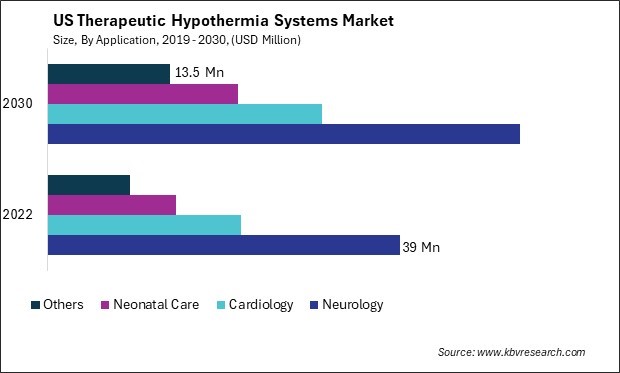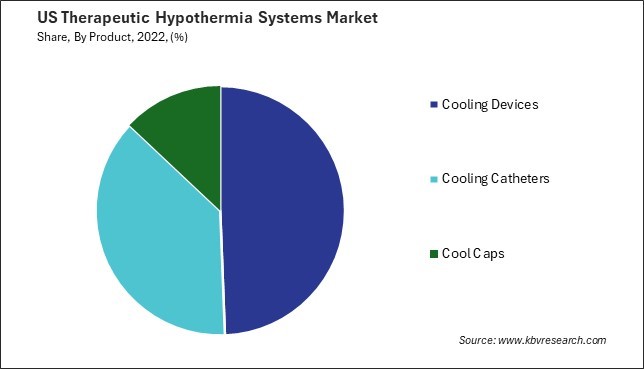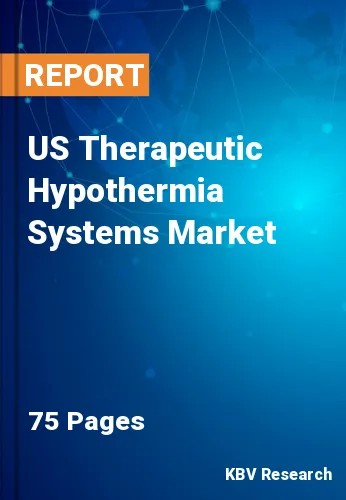The United States (US) Therapeutic Hypothermia Systems Market size is expected to reach $117.4 Million by 2030, rising at a market growth of 4.4% CAGR during the forecast period.
The therapeutic hypothermia systems market in the United States has witnessed significant growth in recent years, driven by advancements in medical technology and an increasing focus on improving patient outcomes in critical care settings. One of the key drivers of the industry in the U.S. is the rising prevalence of cardiac arrest cases. As therapeutic hypothermia has proven to be effective in reducing neurological damage post-cardiac arrest, healthcare providers are increasingly adopting this approach to enhance patient survival rates and improve neurological outcomes.

Hospitals and healthcare facilities across the U.S. increasingly recognize the importance of dedicated therapeutic hypothermia protocols and equipment. Furthermore, the United States Food and Drug Administration (FDA) plays a crucial role in regulating and ensuring the safety and efficacy of therapeutic hypothermia systems. Compliance with FDA regulations is a significant consideration for manufacturers, and obtaining regulatory approval is essential for industry entry and product acceptance.
The COVID-19 pandemic has had a profound impact on the healthcare landscape, including the therapeutic hypothermia systems market in the U.S. The overwhelming influx of COVID-19 patients strained healthcare resources, leading to a reprioritization of medical interventions. While therapeutic hypothermia remained a crucial tool in specific cases, the pandemic's focus on infectious diseases temporarily diverted attention and resources from non-COVID medical interventions.
However, as the healthcare system adapts to the new normal, the importance of therapeutic hypothermia in treating non-COVID-related conditions is regaining prominence. The industry is expected to recover as healthcare providers re-establish their focus on comprehensive patient care, recognizing the significance of therapeutic hypothermia in improving neurological outcomes.
In recent years, the United States has witnessed a remarkable surge in the demand for healthcare and medical services, particularly in therapeutic hypothermia systems. One key driver behind the rise in the therapeutic hypothermia systems market in the U.S. is the expanding awareness among healthcare professionals about the benefits of inducing controlled hypothermia. Medical practitioners are increasingly adopting therapeutic hypothermia as a crucial therapeutic strategy, especially in cases of cardiac arrest, traumatic brain injury, and neonatal hypoxic-ischemic encephalopathy.
Moreover, technological advancements have played a pivotal role in the growth of the therapeutic hypothermia systems market in the U.S. The development of sophisticated and user-friendly cooling devices has made it more accessible for healthcare providers to implement therapeutic hypothermia protocols. These technological innovations have enhanced the precision and safety of inducing hypothermia, contributing to its widespread adoption in clinical settings.
The increasing incidence of conditions such as cardiac arrest and traumatic brain injuries has also intensified the demand for therapeutic hypothermia systems. As the aging population expands and the prevalence of cardiovascular diseases rises, healthcare facilities are prioritizing the integration of therapeutic hypothermia as a standard-of-care approach, driving industry growth.
According to the United States Census Bureau, the older population reached 55.8 million or 16.8% of the population in 2020. Over a century, the older population expanded by 50.9 million, from 4.9 million (4.7% of the total U.S. population) in 1920 to 55.8 million (16.8%) in 2020. As the aging demographic continues to expand, the healthcare industry is likely to witness a growing need for sophisticated and effective therapeutic interventions, including the use of hypothermia systems, to address the unique healthcare challenges associated with an increasingly elderly population in the United States.
Furthermore, the U.S. healthcare system's focus on research and development has spurred continuous improvements in therapeutic hypothermia techniques and equipment. Clinical trials and studies are contributing valuable insights, reinforcing the evidence-based practice of therapeutic hypothermia, and encouraging its incorporation into mainstream medical services. Thus, the surge in demand for therapeutic hypothermia systems in the United States is propelled by heightened awareness among healthcare professionals and a growing emphasis on research-driven improvements.
In the United States, there has been a notable surge in awareness regarding therapeutic hypothermia systems among healthcare professionals, marking a paradigm shift in the approach to patient care. Therapeutic hypothermia, also known as targeted temperature management, involves intentionally lowering a patient's body temperature to mitigate neurological damage following events such as cardiac arrest, traumatic brain injury, or stroke. This innovative approach has garnered increased attention and acceptance within the U.S. medical community, reflecting a growing recognition of its potential benefits.
Furthermore, the integration of therapeutic hypothermia into treatment protocols and guidelines by influential medical organizations has played a pivotal role in shaping clinical practices in the U.S. Institutions such as the American Heart Association (AHA) and the American Stroke Association (ASA) have incorporated therapeutic hypothermia into their recommendations, fostering a standardized and evidence-based approach among healthcare practitioners.
The advancement of technology in therapeutic hypothermia systems has also contributed to increased adoption. The availability of sophisticated cooling devices and temperature management solutions tailored to diverse clinical scenarios has provided healthcare professionals with versatile tools to implement therapeutic hypothermia effectively. Therefore, the notable surge in awareness, endorsement by influential medical organizations, and technological advancements have collectively propelled the widespread adoption of therapeutic hypothermia systems in the United States.

The therapeutic hypothermia systems market in the United States is characterized by a range of companies that play a pivotal role in advancing medical technologies for cooling the body temperature of patients in specific medical conditions. One prominent player in the U.S. therapeutic hypothermia systems market is ZOLL Medical Corporation. ZOLL is renowned for its comprehensive portfolio of medical devices and software solutions, including therapeutic hypothermia systems. These systems are designed to induce and maintain hypothermia in patients post-cardiac arrest, minimizing neurological damage and improving overall outcomes.
Another notable company in this industry is C. R. Bard, Inc., a leading medical technology company that offers a range of products, including therapeutic hypothermia systems. Bard focuses on providing solutions for critical care and has gained recognition for its commitment to enhancing patient outcomes through cutting-edge technologies. The company's presence in the U.S. underscores its dedication to addressing the growing demand for therapeutic hypothermia in various healthcare settings.
The U.S. therapeutic hypothermia systems market also features companies like Philips Healthcare, a global leader in health technology. Philips offers a range of solutions, including therapeutic hypothermia systems, designed to address the complexities of critical care. The company's focus on patient-centric innovation and collaboration with healthcare providers has positioned it as a key contributor to the advancements in therapeutic hypothermia practices in the U.S.
Additionally, companies like Belmont Instrument Corporation have made significant contributions to the U.S. industry with their innovative technologies for temperature management. Belmont's focus on precision and efficiency in therapeutic hypothermia systems has garnered attention in the medical community, contributing to the industry's overall growth.
The competitive landscape also includes companies like MTRE Advanced Technologies Ltd., a provider of temperature management solutions with a notable presence in the U.S. MTRE's commitment to technological excellence and meeting the specific needs of healthcare professionals has solidified its position in the therapeutic hypothermia systems market. These companies play a crucial role in shaping the landscape of therapeutic hypothermia, ultimately improving patient outcomes and addressing the evolving needs of healthcare professionals across the United States.
By Application
By Product
Our team of dedicated experts can provide you with attractive expansion opportunities for your business.

